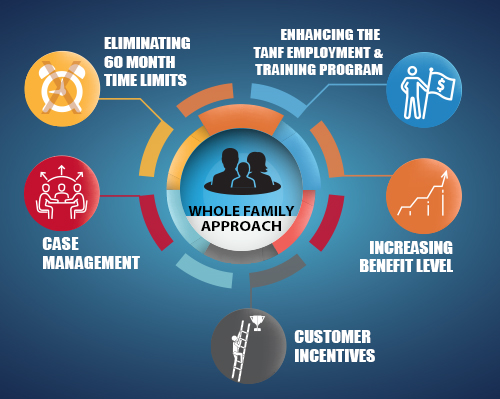
The District’s Temporary Assistance for Needy Families (TANF) program provides cash assistance to families in need, along with a suite of services to facilitate their path to success. Families enrolled in the District’s TANF program may receive benefits so long as they are income-eligible and have a child in the home. TANF also offers access to a variety of supportive services that can be bundled together to meet individual needs. DHS employs a two-generation approach to reaching and serving families so that children and parents can grow together.
Through the TANF program, customers gain access to supportive service,s including but not limited to:
- TANF Employment and Education Program (TEP) – provides coaching towards education and employment goals, but can also coach parents on goals they have for their child(ren) and families
- Child Care Subsidy – allows parents to enroll their child(ren) in quality childcare, including before and aftercare
- Behavioral, Mental Health, and Substance Abuse Support – connects customers to the Department of Behavioral Health (DBH) to obtain counseling to cope and manage behavioral, mental, emotional, or substance abuse issues for parents or their child(ren)
- Tuition Assistance Program Initiative for TANF (TAPIT) – financial assistance to enroll in post-secondary educational programs or professional certificate and/or licensing programs
How to Apply
You can apply for TANF by completing an application, providing documents to verify your eligibility, and participating in an interview.
- Find out if you may be eligible before applying
Applications are accepted online, via mobile application, in-person, or through the mail.
General Program Requirements
To qualify for TANF you must be:
- A resident of the District of Columbia;
- Either pregnant or responsible for a child under 19 years of age;
- A U.S. citizen, legal alien, or permanent resident;
- Meet income requirements based on household size (see Income Requirement table below);
- Complete orientation and assessment through the Office of Work Opportunity (OWO); and
- Develop an Individual Responsibility Plan (IRP).
If you are approved for TANF, unless you are exempt, you must engage with a service provider and maintain compliance with your IRP.
Some customers enrolled in the TANF program may seek an exemption from work requirements. Examples of exemption reasons include but are not limited to:
- Being pregnant
- Having a child under age one
- Experiencing domestic violence
- Having a physical disability that limits work
Income Requirements at Application
The maximum income a family can have per application and still qualify for TANF depends on the family size and childcare costs. The maximum income a family can have, based on household size is below. (Once on TANF, families can earn more, and continue to qualify for benefits).
Income Limits and Maximum Monthly TANF Benefit Amounts
|
Effective October 1, 2025 – September 30, 2026 |
||
|
Household Size |
Maximum Monthly Benefit for Cash Programs |
Maximum Monthly Earnings at Application |
|
1 |
$504 |
$664 |
|
2 |
$629 |
$789 |
|
3 |
$803 |
$963 |
|
4 |
$983 |
$1,143 |
|
5 |
$1,136 |
$1,296 |
|
6 |
$1,335 |
$1,495 |
|
7 |
$1,532 |
$1,692 |
|
8 |
$1,691 |
$1,851 |
|
9 |
$1,863 |
$2,023 |
|
10 |
$2,024 |
$2,184 |
If a family has childcare costs, there is a maximum monthly income limit increase of $175 per child age 2 or over and $200 per child under the age of two.
Resource Requirements
Resources are things like bank accounts, money market funds, certificates of deposit, and stocks and bonds. For households that have a resource limit, households may have $3,000 in countable resources. If the household includes a person who is age 60 or older the resources limit is $4,500. If you apply for TANF, the District will review your information and determine whether you meet the resource requirements
If you think you may be eligible – we encourage you to apply.
Recent Updates to the District’s TANF Program
- Discontinuing Time Limits – Families can now receive benefits beyond the federal 60-month lifetime limit
- Increasing Cash Benefits – benefit levels received a cost of living adjustments (COLA), the cash grant was split between parents and child(ren), and sanctions were redesigned
- Enhancing Employment & Training Services – Effective October 1, 2024, TEP will provide employment and education services together under one provider. Customers participating in TEP will also be able to choose how they participate. This is called the Family Choice Model (FCM). In the FCM, customers can choose whether they work with a provider or independently on the self-directed path. On the self-directed path, customers will have support from DHS as they need it.
- Providing Bonuses – offering financial rewards (in addition to the monthly cash grant) when education and employment goals are achieved and for engaging in the TEP in a meaningful way. Customers participating in TEP can also receive financial rewards for completing specific Two-Generation (2Gen) milestones. All these financial rewards will help families maximize their TANF benefits so children and parents can rise together.
- For questions about TEP, please email [email protected] or call 202-645-8205.
- Improving Customer Service – DHS has made Service Center renovations and improvements, adjustments to operating hours, and continues to evaluate ways to improve the customer experience

Learn more about the Two-Generation Approach
Verification Requirements
Single Source Verification of Living With a Relative and Proof of Relationship
Single Sources (only 1 required)
• Court custody order stating that the caregiver has physical custody of the child
• School records to include a written statement from a school official*
• Designation of standby guardianship or court petition for standby guardianship with evidence that the triggering event occurred
• Self-attestation (form linked below or handwritten with all required information)
• Hospital, clinic, physician, or health department records, or written statement from health care provider*
• Childcare records or written statement from childcare provider*
• Child welfare agency records or written statement from agency caseworker*
• Written statement from community provider*
• Written statement from non-relative*
• Written statement from clergy*
• Written statement from non-relative landlord*
• DC Office of the State Superintendent of Education (OSSE) OPC form if the box for “enrolling student resides with me, the other primary caregiver”
is checked.
*ESA will make collateral contact with the source of the statement.
Use the linked form to prove (verify) self-attestation of “Relationship” and “Living with a Relative” for Temporary Assistance for Needy Families (TANF).